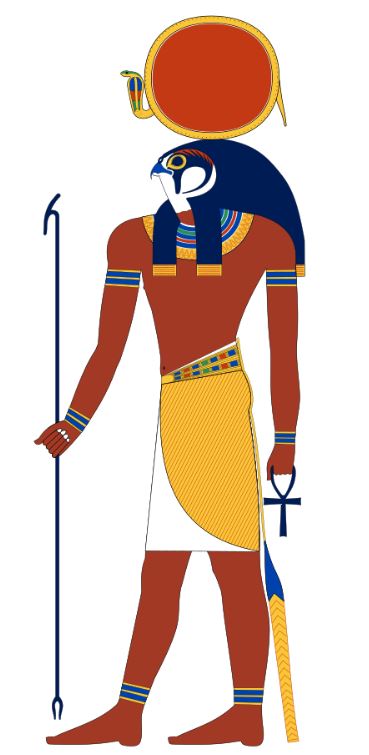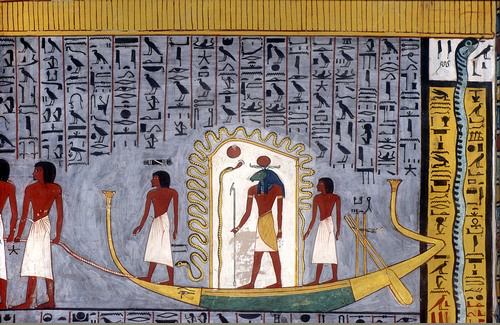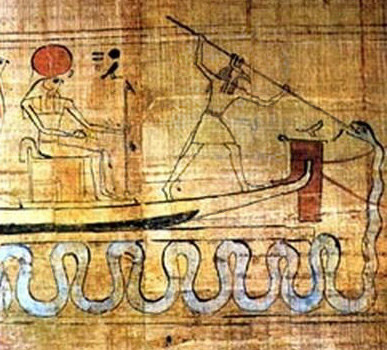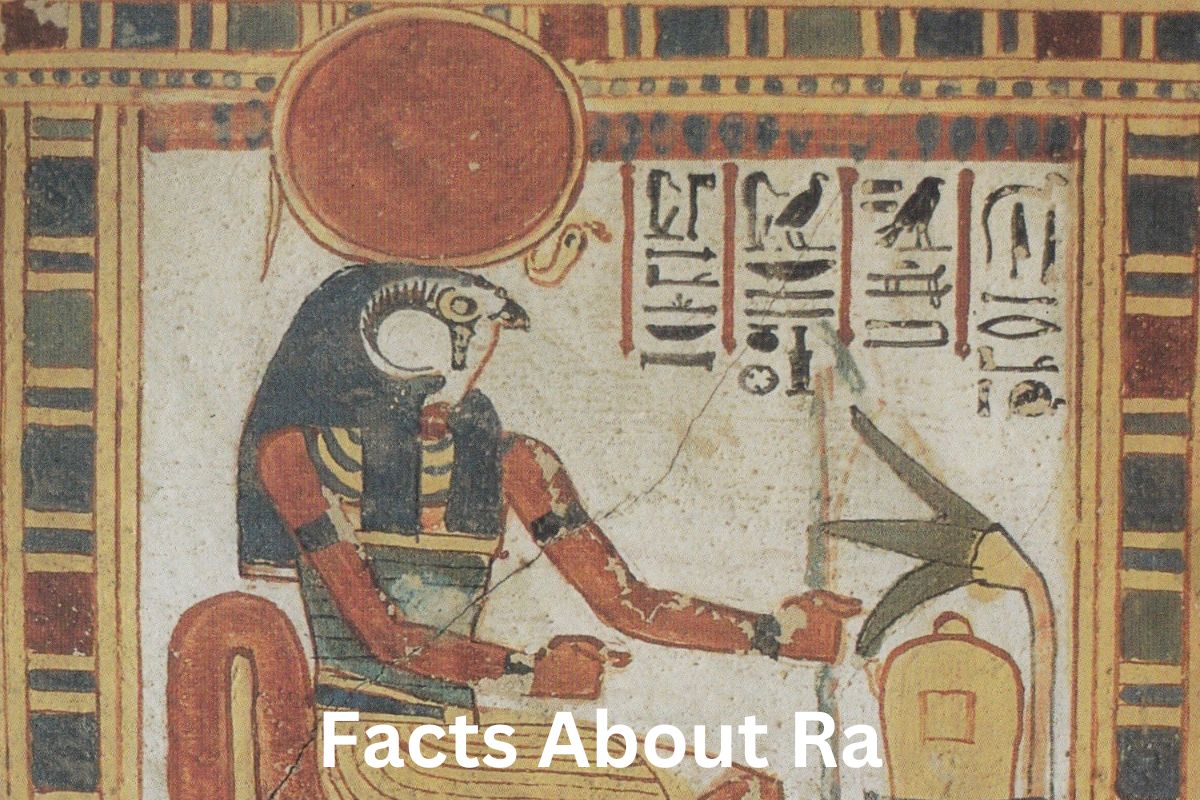Ra is an ancient Egyptian deity, known primarily as the god of the sun and the creator of life. As one of the most significant gods in the Egyptian pantheon, Ra’s influence can be seen throughout various aspects of ancient Egyptian culture, religion, and mythology.
Often depicted as a man with the head of a falcon, crowned by a solar disk encircled by a cobra, Ra symbolizes the power of the sun and its life-giving properties.
According to ancient Egyptian beliefs, Ra created the universe by speaking its elements into existence and continues to provide light, warmth, and life to the world through his daily journey across the sky.
The cult of Ra was centered in the city of Heliopolis, an essential religious hub in ancient Egypt. Over time, Ra became associated with other gods, forming new deities like Amun-Ra and Atum-Ra.
The pharaohs of Egypt were thought to be the earthly embodiments of Ra, with the title “son of Ra” signifying their divine connections.
Ra’s worship and importance in ancient Egyptian society reached its peak during the New Kingdom. However, as Christianity spread throughout Egypt, the worship of Ra and other Egyptian gods began to decline.
Ra Egyptian God Facts
1. Egyptian god of the sun
Ra, the ancient Egyptian god of the sun, played a crucial role in the Egyptian pantheon.
As the creator of life, Ra was revered for his influence on the natural world and the daily lives of the Egyptian people.
Also Read: Eye of Ra
His worship spanned thousands of years, with his importance evolving and adapting throughout the different periods of ancient Egyptian history.
2. Falcon headed man
The iconography of Ra features a combination of human and falcon elements, symbolizing his power and divine status.

The falcon head represents swiftness and the sky, while the human body signifies Ra’s connection to humanity.
The solar disk atop his head, encircled by a cobra, is known as the “Aten” and embodies the life-giving force of the sun. This representation emphasizes Ra’s role as the source of all life and energy in the world.
3. The solar disk
The Aten, or solar disk, was a central symbol in ancient Egyptian religion. As the embodiment of the sun’s power, the Aten was associated with the life-sustaining properties of sunlight.
Ra’s connection to the Aten reinforced his status as the creator of life and the driving force behind the world’s natural processes.
4. Heliopolitan creation myth
According to Egyptian mythology, Ra created the universe by uttering its elements into existence.
This act of creation, called the “Heliopolitan creation myth,” established Ra as the supreme god responsible for shaping the world and its inhabitants.
As the creator, Ra held a special place in the hearts and minds of the ancient Egyptians.
5. Ra’s solar barque
In Egyptian beliefs, Ra’s daily journey across the sky in his solar barque signified the sun’s constant presence and its life-giving properties.

This journey was seen as a metaphor for the continuous cycle of life, death, and rebirth that characterizes the natural world.
As the sun moved across the sky, it brought light, warmth, and energy to the earth, allowing life to flourish.
6. He battled Apophis every night
The nighttime journey of Ra, in which he traveled through the underworld in a separate boat, was a critical aspect of Egyptian mythology.

During this journey, Ra battled the serpent Apophis, who represented chaos and destruction. By successfully fighting off Apophis each night, Ra ensured the survival of the world and the continuation of life.
This story emphasized the god’s role in maintaining order and balance in the universe, further highlighting his significance in ancient Egyptian culture.
7. The journey of Ra
The journey of Ra through the underworld is intimately connected to the cycle of death and rebirth, both in nature and in human experience.
As the sun sets each day, it is believed to enter the underworld, symbolizing the end of life. When the sun rises again the next morning, it represents the triumph of life over death and the start of a new day.
This cycle mirrors the ancient Egyptians’ beliefs about the afterlife and the possibility of eternal life through proper rituals and honoring the gods.
8. Life, death, and rebirth
Ra’s daily journey through the sky and his nightly travels through the underworld serve as a powerful metaphor for the human experience of life, death, and rebirth.
The ancient Egyptians believed that by understanding and aligning themselves with the gods’ activities, they could secure a favorable afterlife and maintain a connection with their deceased loved ones.
This belief was at the heart of their funerary practices, which included mummification, the construction of elaborate tombs, and the performance of rituals to aid the deceased in their journey through the afterlife.
9. The city of Heliopolis
The cult of Ra was centered in the city of Heliopolis, an ancient religious center in Egypt.
Heliopolis was home to many temples and monuments dedicated to Ra, as well as a thriving community of priests and other religious officials who maintained the god’s worship.
Heliopolis’s status as the center of Ra’s cult made it an important destination for pilgrims seeking to offer prayers and gifts to the sun god.
10. Ra was merged with other gods
Over time, Ra was merged with other gods to create new deities that combined different aspects of Egyptian religious beliefs. Amun-Ra, for example, represented the hidden power of the sun and became a major deity during the New Kingdom period.
Atum-Ra, on the other hand, symbolized the setting sun and the creation of the world. By combining with other gods, Ra’s influence and importance in ancient Egyptian religion continued to grow and evolve.
11. The title “son of Ra” was bestowed upon pharaohs
The pharaohs of ancient Egypt were considered the earthly embodiment of Ra, acting as his representative on earth and maintaining the connection between the divine and mortal realms.
The title “son of Ra” was bestowed upon pharaohs to signify their divine lineage and their responsibility to uphold the principles of Ma’at, the ancient Egyptian concept of truth, balance, and order.
By identifying themselves with Ra, the pharaohs sought to establish their legitimacy and divine authority, further cementing the sun god’s central role in ancient Egyptian society.
12. The worship of Ra peaked during the New Kingdom
The worship of Ra reached its zenith during the New Kingdom (1550-1070 BCE), a period marked by the expansion of Egyptian power and influence.
During this time, Ra became the state god, and his cult merged with that of Amun, another significant Egyptian deity.
Also Read: Amun Egyptian God Facts
This amalgamation created the composite god Amun-Ra, who became the central figure in the state religion.
The association with Amun further elevated Ra’s status, emphasizing his role as a powerful and influential force in the lives of the ancient Egyptians.
13. The Feast of Opet
One of the most important festivals dedicated to Ra and his associated deities was the “Feast of Opet.” This celebration aimed to strengthen the bond between the gods and the people and to rejuvenate the pharaoh’s divine powers.
Held in the city of Thebes, the festival involved a procession of the god Amun-Ra’s statue from the Karnak Temple to the Luxor Temple.
This event allowed the populace to come into close contact with the divine, participate in the rituals, and reaffirm their devotion to the gods.
14. Ra’s connection to other solar deities
Ra’s connection to other solar deities was also significant in ancient Egyptian religion.
One such deity was Horus, who was often seen as the earthly manifestation of Ra or as the sun god in the form of a falcon.
This association with Horus further solidified Ra’s position in the pantheon and allowed for greater exploration of the complex and interconnected nature of Egyptian religious beliefs.
15. The worship of Ra declined as Christianity arrived
As Christianity spread throughout Egypt, the worship of Ra and other Egyptian gods began to decline.
The rise of monotheistic religions led to a shift in religious practices, and eventually, the temples dedicated to Ra and other gods were abandoned or repurposed.
However, the mythology, iconography, and cultural significance of Ra continue to be studied and celebrated in modern times.
As an integral part of ancient Egyptian culture and history, Ra’s legacy endures, providing valuable insights into the beliefs and practices of one of the world’s most fascinating civilizations.
